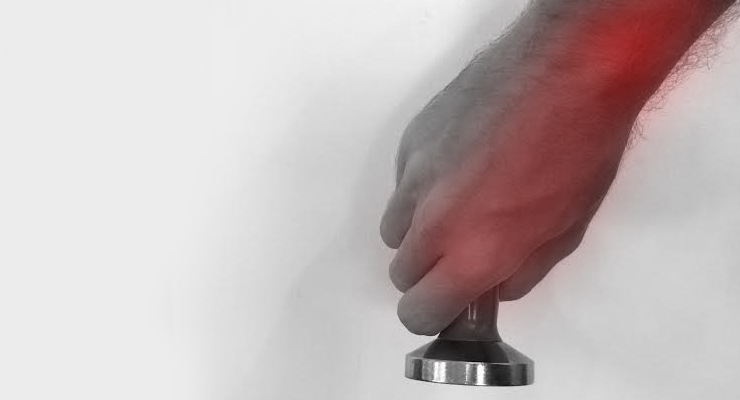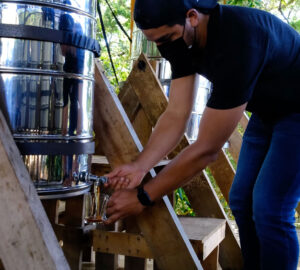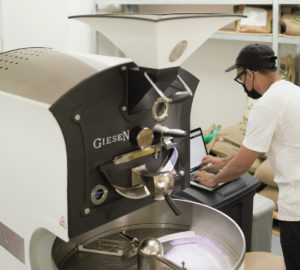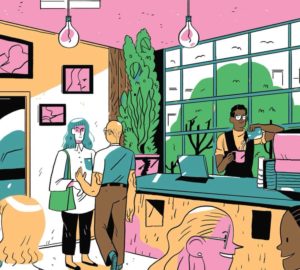According to a study recent study from Wilfrid Laurier University in Waterloo, Ontario, Canada, the intensely repetitive work of making coffee can cause serious lower back and shoulder problems. This may not be news to you if you’ve ever worked a bar shift, or read our three-part study of barista health concerns, but the new study in the journal Ergonomics by Scott Dainty and Dr. Diane Gregory does much to legitimize and quantify the physical strains of barista work.
The study, available here (go open-access journals!), was conducted in a two-part process. First, surveys were distributed to 59 different baristas working at 18 different cafes representing a cross-section of the Waterloo, Ontario coffee market, both chains and independents—80% of those surveyed experienced lower back pain, and 50% attributed that pain to their jobs. Second, 10 of those survey respondents who reported pain were analyzed for working ergonomics using fancy video force-loading measurement software.
A central finding of the study is that tamping coffee is the bar task with the most potential for physical damage, more so than lifting milk jugs or other repetitive barista tasks. The second major part of this finding is that most of the potentially damaging force applied on the body during tamping is working on the lower back, not the shoulders. The National Institute for Occupational Safety and Health defines 3400 newtons of force as the safe limit for repeated actions at work. In an informal chat with Sprudge, Dr. Gregory says the study observed forces of between 2800 and 4100 newtons in baristas while tamping.
Which isn’t to say that those who tamp more softly are safe from barista-related injuries. Dr. Gregory stressed that even sub-threshold loads that are continuously repeated throughout an individual’s workday may cause damage, due to the “cumulative loading” on the joints and muscles. Dr. Gregory and her students at Wilfrid Laurier University also observed a number of “high shoulder moments” in the tamping baristas, which can lead to shoulder damage as well. A high shoulder moment is when force is being applied to a joint at a long distance from that joint, making the effect of the force more intense and potentially damaging—think of how much harder it is to lift a weight with your arms extended all the way out from your shoulders, versus curled in closer to your body.
When asked what suggestions for preventing barista injury can be drawn from the study, Dr. Gregory explained that it is important to rotate through different tasks that change the loading on tissue and not just work one job position. She also said that cumulative loading and work injury can be a challenging beast to nail down: what a barista does after their shift can have a big impact on the whether or not they are varying their tissue loading sufficiently throughout the day, and that it’s important to have a “balance between tissue exposure and a chance to mend. “
Another problem is that baristas with lower back or shoulder pain may be compensating for it with awkward postures or application of force that actually cause higher shoulder moments and more pain in the long term. Dr. Gregory noted it’s important to focus on minimizing awkward postures, and be very attuned to what your body is telling you. If a posture or motion causes pain or a twinge, it’s important to be mindful of that, and that it’s important to get managerial staff on board with position rotation and other ergonomic concerns. Lastly, she encouraged anyone experiencing persistent pain to talk to an occupational therapist or other medical personnel.
A lot of the findings in this study echo issues we ourselves observed in our own barista health study, and some of Dr. Gregory’s suggestions were already part of the mitigation strategies that we found some coffee companies had implemented. It’s great to see serious scientific work being done in this area, and Dr. Gregory added that with the public interest the study has received, they are interested in looking more into the ergonomics of coffee service workers.
In both our formal investigations and informal conversations, we’ve found that figuring out how to make coffee in a more physically sustainable way is a big concern in the increasing professionalization of barista work. This study from Dainty and Gregory points to the validity of those concerns and also offers clear steps towards improvement. Hopefully their work will be a stepping stone for further inquiry, not just in academia, but in the application of better, safer practices in busy coffee bars around the world.
Alex Bernson (@AlexBernson) is the Assistant Editor at Sprudge.com. Read more Bernson here.



































